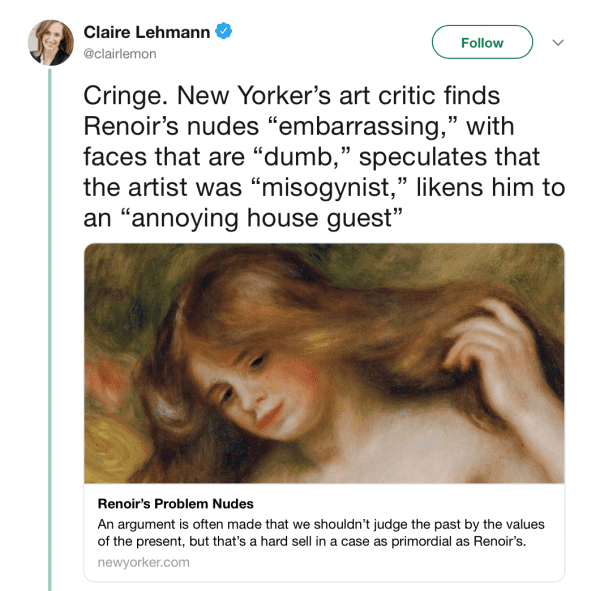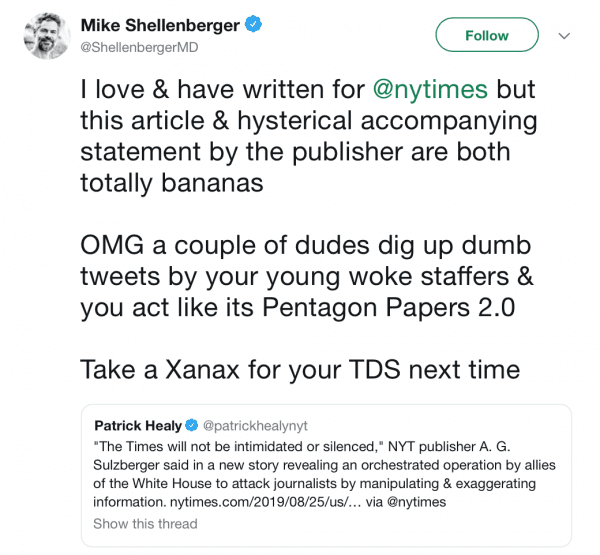BONFIRE OF THE TRANNITIES: Medical Expert: Doctors Are Actually Giving Trans Kids a Disease, It’s Child Abuse.
(Classical reference in headline.)
BONFIRE OF THE TRANNITIES: Medical Expert: Doctors Are Actually Giving Trans Kids a Disease, It’s Child Abuse.
(Classical reference in headline.)
WELL, THAT’S ONE WAY TO TEACH A KEY BYPRODUCT OF SOCIALISM: ‘Monopoly: Socialism’ Game Disappears From Target’s Website.
OUR CULTURAL LEADERS ARE BUSY DISCREDITING THEMSELVES:

IT’S COME TO THIS: Stop Sharing Those Viral Photos of the Amazon Burning, says…Mother Jones, astonishingly enough.
Earlier: Don’t Panic: Amazon Burning Is Mostly Farms, Not Forests.
OPEN THREAD: It’s real, and it’s spectacular.
THE 100 BEST JAZZ ALBUMS YOU NEED IN YOUR COLLECTION: Even the author admits that this is Brit GQ’s “totally subjective list of the 100 best jazz albums in the world * *Purists beware. You may be alarmed and offended,” but what’s fascinating is the throat-clearing before getting to the list:
“Jazz is for people who don’t like music,” says GQ’s Deputy Editor; it must be fun to play, he says, because it sure ain’t fun to listen to. (“I remember this tune,” he’ll say, “which is more than the guy playing it does.”) It is, in the words of some forgotten Eighties comedian, six guys on stage playing different tunes. GQ even ran a joke about it a few years ago: “Q: Why do some people instantly hate jazz?” “A: It saves time in the long run.” Even my youngest daughter hated it at the time. Aged five, after being subjected to hours of Charlie Parker in the car one weekend, she said, “I don’t like this music. There are no songs for me to sing to.” (The only jazz tune she liked is “Everybody Want To Be A Cat” from Disney’s The Aristocats.) Unbeknown to her, she was echoing John Lennon’s little-known jibe: “Jazz never does anything.”
Some people’s innate hatred of jazz is simply the result of an unfortunate experience, but then anyone who’s witnessed Art Blakey performing a three-and-a-half hour drum solo is entitled to feel a little peeved (and I speak as someone who has seen one at close quarters). On top of this, some people just don’t get it. Like the later work of James Joyce, the films of Tarkovsky and “tax harmonisation”, the fact that some things will always lie just beyond the common understanding is something jazz enthusiasts must learn to live with.
Also, jazz has often been victim to the vagaries of fashion, destined to be revived at the most inappropriate moments. The last time jazz was really in the limelight was back in the mid-Eighties, when it became the soundtrack du jour in thousands of matt-black bachelor flats all over designer Britain and when every style magazine and beer ad seemed to look like a Blue Note album cover. Jazz went from being a visceral, corporeal music to a lifestyle soundtrack. This was the age of Style Council, of Absolute Beginners… of Sting. Buying into jazz was meant to lend your life a patina of exotic sophistication and was used to sell everything from Filofaxes and coffee machines to designer jeans and sports cars.
In his excellent book, Jazz 101: A Complete Guide To Learning And Loving Jazz, John F Szwed writes: “The life and look of the black jazz musician offered a double attraction, that of the alienations of both artist and colour. Whatever jazz might have been as an actual occupation, the jazz musician offered one of the first truly nonmechanical metaphors of the 20th century. Now, whether one has heard of Charlie Parker or not, we inherit a motion of cool, an idea of well-etched individuality, a certain angle of descent.”
If jazz started life as a subversive sexual extension of ragtime, blues, boogie-woogie and the New Orleans sound, by the end of the century it had become the soundtrack of accomplishment, a way of upstairs acknowledging downstairs in the manner of nostalgie de la boue.
Read the whole thing, though if you know even the tiniest bit about popular postwar jazz albums, you’ll spot the number one title on the list coming from a mile away.
(Via Terry Teachout.)
WHOM THE GODS WOULD DESTROY, THEY FIRST MAKE RIDICULOUS:

RACISM SHIBBOLETHS ARE THE FIRST RESORT OF SCOUNDRELS: Instead of floating the White Australia bogey, let’s be honest about Chinese influence.
Given these pitiful distractions would see Spence trounced in a high school debate it’s reasonable to ask why he wants to slap a racist stop clause on this discussion. Maybe he doesn’t want to address the mess he, and many of his fellow vice-chancellors, made as they built gilded palaces on the rivers of gold flowing from full-fee-paying foreign students, most of whom come from China.
This has brought a series of wicked dilemmas, some of which would be bad ideas when dealing with any large group of foreign nationals, and others which arise from the fact that China is a deeply intolerant, easily offended and increasingly aggressive single-party state.
Yes.
LINDA SARSOUR RESPONDS–STILL LYING: Earlier, I noted that Sarsour had tweeted that “right-wing Zionists” were hanging out with KKKers who were holding Confederate flags protesting a speech she gave in March. Here and on Twitter, I presented photos and video of the event that showed no sign of any KKKers or Confederate flags (much less both!), and noted that she had once again shown herself to be a lying antisemite. Here is Sarsour’s response on Twitter:
You don’t have to be especially astute to notice that while there is one guy holding a Trump flag, one guy holding a Betsy Ross and Gadsen flag, several Israeli flags, several modern American flags, several Christian flags (utterly mainstream), and one guy with an “Armed infidel” flag, there are no Confederate flags to be seen, nor any indication that anyone is affiliated with the KKK. Nor, for that matter, is there any indication that the Israeli flag-wavers are “right-wing Zionists,” as opposed to people of whatever ideology appalled by Sarsour’s antisemitism-laden genocidal hostility to Israel. So, still a liar.
DISPATCHES FROM THE INTERSECTION OF THE EDUCATION APOCALYPSE AND LIBERAL FASCISM: Former Antifa College Professor: Kill Christians, Clock Trump With a Bat.
WELL, SOMEONE HERE IS DELUSIONAL: Duke Psychiatrist: Trump ‘May Be Responsible for Many More Millions of Deaths’ than Hitler. Stalin, and Mao.
CANCEL CULTURE COMES FOR RENOIR: “Renoir’s Problem Nudes. An argument is often made that we shouldn’t judge the past by the values of the present, but that’s a hard sell in a case as primordial as Renoir’s,” says the New Yorker, in a classic example of what C.S. Lewis dubbed “chronological snobbery:”
C.S. Lewis coined the term “chronological snobbery.” It is defined as the belief that “the thinking, art, or science of an earlier time is inherently inferior to that of the present, simply by virtue of its temporal priority or the belief that since civilization has advanced in certain areas, people of earlier time periods were less intelligent.” If we add, “and therefore wrong and also racist” to this definition, we would have a perfect definition of today’s SJWs.
Historian Larry Taunton defines it as “imposing the mores of our own time on those who lived in another.”
“Cancel culture is spreading for one simple reason: it works,” Jon Gabriel recently wrote. “Instead of debating ideas or competing for entertainment dollars, you can just demand anyone who annoys you to be cast out of polite society.”
Or as Iowahawk tweets in response to the New Yorker, “By current standards this now qualifies [former Attorney General John] Ashcroft as an art critic for the New Yorker, curator of the Met, and a tenured faculty member at Yale,” adding “The most amazing thing about the New Yorker article is the writer literally wants to get prurient art Banned in Boston.”
LIKE SO MANY CARS TODAY, THEY’RE BOTH MIND-BOGGLINGLY FAST AND CAPABLE: 2020 Toyota GR Supra vs. 2019 Ford Mustang Shelby GT350: Which Is the Better Driver’s Machine?
FAKE NEWS ISN’T NEW: On this day in 1835, the New York Sun began the Great Moon Hoax. The pictures are great.
NEW YORK TIMES PUBLISHER IRKED AT TRUMP ALLIES’ EFFORT TO FIGHT BACK AGAINST MEDIA:
New York Times publisher A.G. Sulzberger issued a lengthy statement on Sunday afternoon to newsroom staff, a statement published in a release by the Times and quoted in a longer article by the newspaper on efforts by allies of President Donald Trump to combat the media through exposing racism and antisemitism inside the establishment media, including the Times.
* * * * * * * *
“We published an article today revealing a coordinated campaign by President Trump’s allies to attack hundreds of journalists in retaliation for coverage of the administration,” Sulzberger wrote, and continued, saying:
This unprecedented campaign appears designed to harass and embarrass anyone affiliated with independent news organizations that have asked tough questions and brought uncomfortable truths to light. The New York Times, which has distinguished itself with fearless and fair coverage of the president, is one of the main targets of this assault. Unable to challenge the accuracy of our reporting, political operatives have been scouring social media and other sources to find any possibly embarrassing information on anyone associated with The Times, no matter their rank, role or actual influence on our journalism.
To be fair, it doesn’t require much of a “scour.”
As Jim Treacher tweets, “The press is supposed to doxx grandmas who post Facebook memes, and forklift drivers who make pro-Trump videos. Those tactics aren’t to be used by mere civilians. Who do they think they are, gatekeepers??“